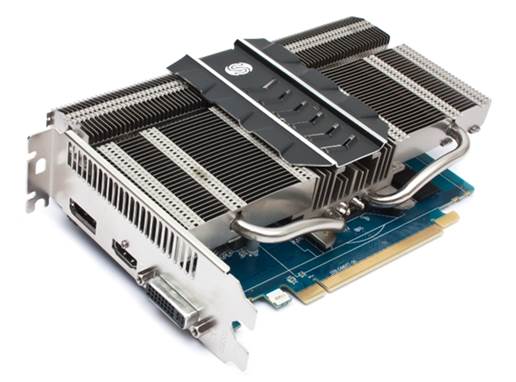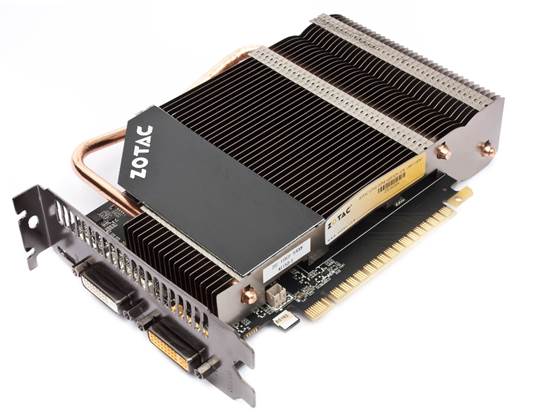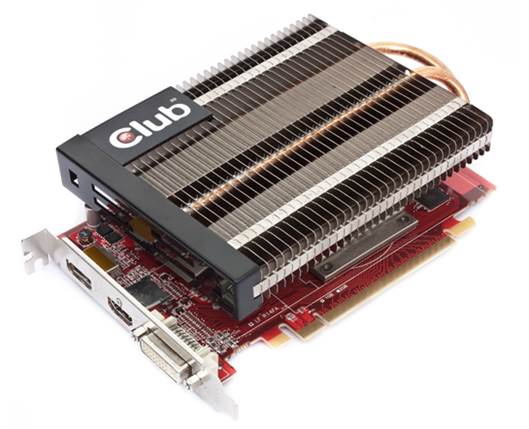Sapphire Radeon HP 7750 Ultimate
Sapphire's Radeon HD 7750 Ultimate is the
company's attempt to make a fanless graphics card using AMD's HD 7000 series
design, and before we go any further, let's defuse the tension: it's really
quite good indeed.
Sapphire's 'Ultimate' series has been
around for a decade, so it's no surprise that the company's got its act sorted
when it comes to making silent graphics cards. As if to prove that, Sapphire
designs its own heatsinks, channeling years of expertise into producing a card
that, in this case, is otherwise identical to the reference version.

Sapphire
Radeon HP 7750 Ultimate
That means 1GB of GDDR5 and an 800MHz GPU
which, when idle, draws a fairly conservative eight watts, that can rise up to
42 watts while fully loaded. Only the heatsink sets it apart, and while it's
massive, it's justifiably so - if anything, there's more heatsink here than the
card needs, which can only be a good thing in terms of keeping it cool. It's a
dual-height card, but the heatsink overkill means it shouldn't require any
extra airflow beyond the amount its size already gives it.
One crucial fact about the HD 7750 Ultimate
is that it isn't substantially more expensive than any other HD 7750 design,
despite being a 'specialist' product. You can expect to pay around $8- $16 more
for this than the version with a fan, which is fair value. That said, the HD
7750 was overpriced to begin with, given that its performance isn't
substantially better than its last-gen equivalent. The Radeon HD 6750 is
available for around $124 and performs almost as well as the HD 7750 in the
case of the latter, you're paying for a lower operating temperature and lower
power consumption, rather than superior performance.
Of course, it's those qualities which make
the HD 7750 Ultimate such a good silent card, so if that's your preference,
this is definitely the card to buy.
DETAILS
·
Price: $150
·
Architecture: Cape Verde (28nm)
·
Memory: 1GB GDDR5
Zotac GeForce GT 640 Zone Edition
Zotac's version of the GeForce GT 640 comes
in two versions - a regular, active-cooled version, and a silent 'Zone
Edition'. The GK107 GPU uses a 28nm Kepler process, and clocks at 902MHz, which
is a little slower than the reference design of 950MHz - presumably to keep the
temperature down.
That said, this is one of the few cards
with 2GB of RAM, even if it is slightly slower GDDR3, not GDDR5. In terms of
I/O ports, you get two DVIs and a mini-HDMI, but no Display Port. It's a
double-height design and doesn't require a separate power supply, but aside
from the large heatsink it's fairly generic-looking.
Despite the extra RAM, the card's
performance is unremarkable against its peers. You'll need to maintain a lot of
airflow around the card in order to keep it happy temperature-wise, and the
poor performance of GDDR3 memory means it's hard to run at higher resolutions
without seeing a noticeable performance drop. Much of this would be forgivable,
were it not for the high price: it's substantially worse than the Sapphire HD
7750, which costs only a fraction more.

Zotac
GeForce GT 640 Zone Edition
One of the few stand-out areas could be
found in the card's power consumption. While idling, it draws only 9 watts and
barely cracks 15 watts when playing video. This, combined with the lack of fan
noise might make it a good choice for HTPCs, but only if you're also planning
to do some gaming on them - otherwise, it's simply far too powerful to make for
an economic choice.
So while it's not completely incompetent as
graphics cards go, it does suffer from that old problem: it's just not good
enough in any area to make it worth recommending for any purpose. If you can
find it at substantial discount (we're thinking 20% or more) then it arguably
becomes competitive - but if you're after a silent graphics card that can play
modern games, this isn't the best, or even second best.
DETAILS
·
Price: $128
·
Architecture: Kepler (28nm)
·
Memory: 2GB GDDR3
Club3D Radeon HD 7750 RoyalQueen
Following a similar pedigree to the Sapphire
Radeon HD 7750 Ultimate, the Club3D Royal Queen is based on the same reference
design (the Radeon HD 7750) and features a passive cooling heatsink rather than
a fan. Again, aside from the cooling method it sticks rigidly to the reference
design, so you get 1GB of GDDR5 and an 800MHz GPU. IO ports include one DVI,
one HDMI and one Display Port, as on the Sapphire and reference boards.
The main (arguably, the only!) difference
between this and Sapphire's version is the heatsink. Club3D's version is a lot
more conservative in both design and size. Unlike Sapphire's design, which
curves around the base, this one covers the top of the card only.
It doesn't noticeably impact on
performance, but operating temperatures are slightly higher and therefore you'd
expect the lifespan and failure rate to be slightly higher as well - although
not so significantly that we'd call it a problem.

Club3D
Radeon HD 7750 RoyalQueen
Again, it's a little more expensive than a
reference HD 7750, but in this case only a shade less so. At this end of the
market, $6.1 is unlikely to make a noticeable dent in a budget, so in that
sense it's no better than the Sapphire version of the card. The same assessment
applies: it's expensive compared to other cards, but about as good as silent
graphics cards get, which makes paying for if silence is your preference.
In-game performance allows high-quality at HD resolutions, but don't expect to
go much beyond 1920x1080 in demanding titles. Power consumption is low. It's
all a very familiar story, really.
Indeed, were it not for the existence of
the Sapphire version, we'd probably be recommending this card. The problem is
that the Sapphire, with its superior cooler (and, let's face it, more
attractive design) does exist, and for a price difference that can all but
disappear once you factor in postage differences between stores.
If the Sapphire is out of stock, this makes
a brilliant replacement, but in sticking so close to the reference (and thus
failing to provide any USP of its own) this card has ultimately been beaten
into second place.
DETAILS
·
Price: $140
·
Architecture: Cape Verde (28nm)
·
Memory: 1GB GDDR5